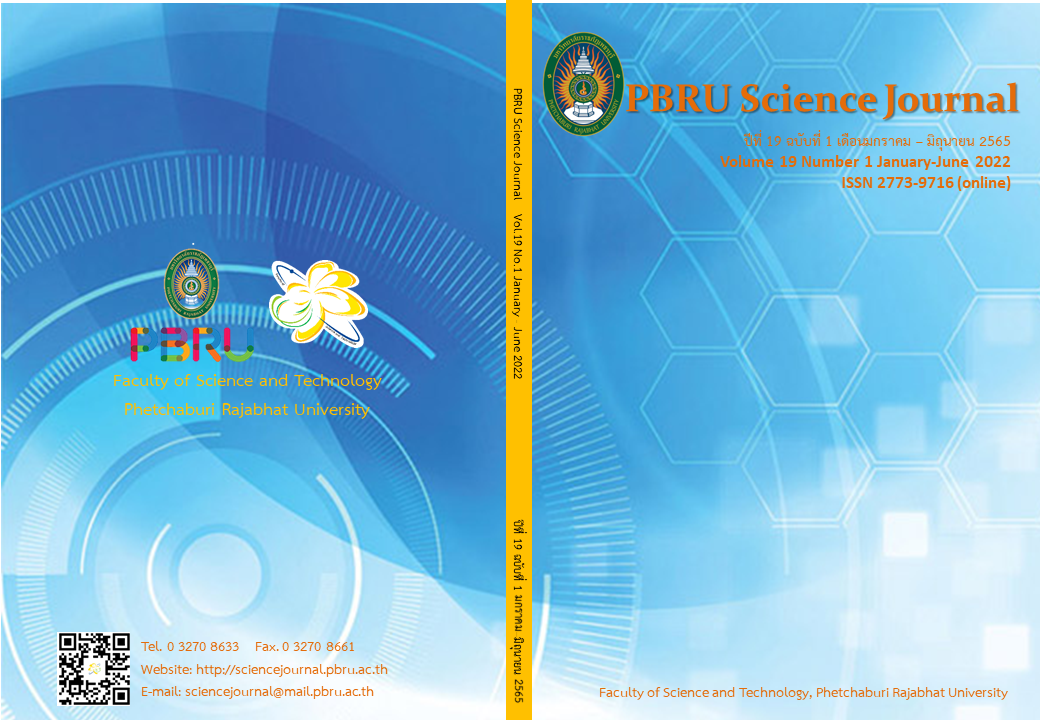การชักนำให้เกิดแคลลัสจากชิ้นส่วนลำต้นใต้ใบเลี้ยงของมะเขือเทศสีดา (Lycopersicon esculentum Mill.) พันธุ์เพชรชมพู
Main Article Content
บทคัดย่อ
มะเขือเทศ (Lycopersicon esculentum Mill.) เป็นพืชเศรษฐกิจที่สำคัญ และมีพื้นที่เพาะปลูกทั่วโลกงานวิจัยนี้มีวัตถุประสงค์เพื่อศึกษาผลกระทบของสารควบคุมการเจริญเติบโตของพืชต่อการเกิดแคลลัสของมะเขือเทศสีดาพันธุ์เพชรชมพู โดยนำชิ้นส่วนลำต้นใต้ใบเลี้ยงเพาะเลี้ยงบนอาหารสูตร MS (Murashige & Skoog) ที่เติม BAP และ NAA ในความเข้มข้นต่าง ๆ เป็นเวลา 4 สัปดาห์ เพื่อศึกษาผลกระทบของสารควบคุมการเจริญเติบโตของพืชที่มีต่อจำนวนวันในการเกิดแคลลัส ค่าเปอร์เซ็นต์การเกิดแคลลัส และค่าน้ำหนักสดแคลลัส ผลการศึกษาพบว่าอาหารเพาะเลี้ยงที่เติม BAP 2.22 ไมโครโมลาร์ ร่วมกับ NAA 8.06 ไมโครโมลาร์ เป็นสูตรอาหารที่เหมาะสมต่อการชักนำให้เกิดแคลลัส โดยมีค่าเปอร์เซ็นต์การเกิดแคลลัสเท่ากับ 100% และมีค่าน้ำหนักสดเฉลี่ยสูงที่สุดเท่ากับ 2.30 กรัม นอกจากนั้นยังใช้เวลาในการเกิดแคลลัสน้อยที่สุดด้วย การรักษาสภาพแคลลัสที่ชักนำได้ จากชิ้นส่วนลำต้นใต้ใบเลี้ยงบนอาหารเพาะเลี้ยงสูตร MS ที่เติม BAP ร่วมกับ NAA พบว่าแคลลัสสามารถเพิ่มจำนวนได้ ผลการศึกษาครั้งนี้สามารถนำไปใช้เป็นพื้นฐานสำหรับการขยายพันธุ์และการปรับปรุงพันธุ์มะเขือเทศสีดา ด้วยการเพาะเลี้ยงเนื้อเยื่อพืช
Article Details

อนุญาตภายใต้เงื่อนไข Creative Commons Attribution-NonCommercial-NoDerivatives 4.0 International License.
บทความที่ได้รับการตีพิมพ์เป็นลิขสิทธิ์ของ PBRU Science Journal
เอกสารอ้างอิง
Bhatia P, Ashwath, N, Senaranta, T and Midmore DJ. Tissue Culture Sudies of Tomato (Lycopersicon esculentum). Plant Cell, Tissue and Organ Culture 2004;78:1-21. Doi:10.1023/b:ticu.0000020430.08558.6e
Food and Agriculture Organisation of the United Nation (FAO). Food and Agriculture data, [Internet]. 2021. Available from: http://www.fao.org/faostat/en/#data/QC. 2021.
Kalloo G. Genetic Improvement of Tomato. In Monographs on Theoretical and Applied Genetics. New York: Springer-Verlag; 1991.
Butelli E, Titta, L, Gorgio, M, Mock HS and Mantos, A. Enrichment of Tomato Fruit with Health-Promoting Anthocyanins by Expression of Select Transcription Factors. Nature Biotechnology 2008;26:1301-8. Doi:10.1038/nbt.1506
Rao AV and Rao LG. Carotenoids and Human Health. Pharmacological Research 2007;55:207-16. Doi:10.1016/j.phrs.2007.01.012
สำนักงานเศรษฐกิจการเกษตร. ข้อมูลการผลิตสินค้าเกษตร. [อินเทอร์เน็ต]. 2564. เข้าถึงได้จาก :http://www.oae.go.th/assets/portals/1/fileups/prcaidata/files/tomato%2063.pdf.
ฝากจิต ปาลินทร ลาภจิตร. ปัญหาและความต้องการในการผลิตมะเขือเทศสีดาของเกษตรกรในจังหวัดนครราชสีมา. แก่นเกษตร 2557;42 (ฉบับพิเศษ 3):894-8.
Toyoda H, Tanaka N, Hirai T. Effects of The Culture Filtrate of Fusarium oxysporum f. sp. lycopersici on Tomato Callus Growth and the Selection of Resistant Callus Cells to the Filtrate. Japanese Journal of Phytopathology 1984;50:53–62. Doi:10.3186/jjphytopath.50.53
Toyoda H, Shimizu K., Chatani K, Kita N, Matsuda Y, Ouchi S. Selection of Bacterial Wilt-Resistant Tomato Through Tissue Culture. Plant Cell Report 1989;8:317-20. Doi:10.1007/bf00716663
Toyoda H, Matsuda Y, Hirai T. Resistance Mechanism of Cultured Plant Cells to Tobacco Mosaic Virus (III) Efficient Microinjection of Tobacco Mosaic Virus into Tomato Callus Cells. Annals of the Phytopathological Society of Japan 1985;51:32-38. Doi:10.3186/jjphytopath.51.32
Seo YS, Choi J Y, Kim SJ, Kim EY, Shin JS, Kim WT. Constitutive Expression of CaRma1H1, a Hot Pepper ER-Localized RING E3 Ubiquitin Ligase, Increases Tolerance to Drought and Salt Stresses in Transgenic Tomato Plants. Plant Cell Report 2012;31: 1659-65. Doi:10.1007/s00299-012-1278-0
Jain SM, Shahin EA, Sun S. Interspecific Protoplast Fusion for the Transfer of Atrazine Resistance from Solanum nigrum to Tomato (Lycopersicon esculentum L.). Plant Cell, Tissue and Organ Culture 1988;12:189-92. Doi:10.1007/bf00040084
Newman PO, Krishnaraj S, Saxena PK. Regeneration of Tomato (Lycopersicon esculentum Mill.): Somatic Embryogenesis and Shoot Organogenesis from Hypocotyl Explants Induced With 6-Benzyladenine. International Journal of Plant Science 1996;157:554-560. Doi:10.1086/297375
Plastira VA, Perdikaris AK. Effect of Genotype and Explant Type in Regeneration Frequency of Tomato In Vitro. Acta Horticulturae 1997;447:231-4. Doi:10.17660/ActaHortic.1997.447.47
Khalilueva MR, Bogoutdinovaa LR, Baranovaa GB, Baranovaa EN, Kharchenkoa, PN, Dolgova SV. Influence of Genotype, Explant Type, and Component of Culture Medium on In Vitro Callus Induction and Shoot Organogenesis of Tomato (Solanum lycopersicum L.). Biology Bulletin 2014;6:512-21. https://doi.org/10.1134/s1062359014060041
Setiaji A, Annisa RR., Sismindari E, Rumiyati, R, Semiarti E. Induction and Growth Kinetics Callus of Tomato (Solanum lycopersicum). Biosaintifika 2020;12:35-41. Doi:10.15294/biosaintifika.v12i1.21704
Pullaiah T, Subba Rao MV, Sreedevi E Tissue Culture Media. In Plant Tissue Culture: Theory & Practicals 2nd edition. Jodhpur: Scientific Publisher. 2017.
Harish MC, Rajeevkumar S, Sathishkumar R. Efficient In Vitro Callus Induction and Regeneration of Different Tomato Cultivars of India. Asian Journal of Biotechnology 2010;2:178-84. Doi:10.3923/ajbkr.2010.178.184
Kumar A, Shilpa C, Kaur R. Establishment and Regeneration of Callus Cultures in Tomato (Solanum lycopersicum L.) from Various Explants. Annual Research & Review in Biology 2017;12:1-6. Doi:10.9734/arrb/2017/32103
Hanur VS, Krishnareddy B. In Vitro Organogenesis in Tomato (Solanum lycopersicum) Using Kinetin. Advanced in Plants & Agricultural Research 2016;4:397-401. Doi:10.15406/apar.2016.04.00158
Chaudhry Z, Habib D, Rashid H, Qurashi, AS. Regeneration from Various Explants of In Vitro Seedling of Tomato (Lycopersicon esculentum L., cv. Roma). Pakistan Journal of Biological Sciences 2004;7:269-72. Doi:10.3923/pjbs.2004.269.272
Lin YH, Chang C, Chang WC. Plant Regeneration from Callus Culture of a Paphiopedilum Hybrid. Plant Cell, Tissue and Organ Culture 2000;62:21-25. Doi:10.1023/A:1006425214471
Samantaray S, Rout GR, Das P. An In Vitro Study on Organogenesis in Trema orientalis. Plant Science 1995;15:87-94. Doi:10.1016/0168-9452(94)04037-h
Smith RM. Plant Tissue Culture: Techniques and Experiments 3rd edition, San Diego: Academic Press; 2012.
Chan LK, Koay SS, Low PH, Boey PL. Effect of Plant Growth Regulators and Subculture Frequency on Callus Culture and the Establishment of Melastoma malabathricum Cell Suspension Cultures for the Production of Pigments. Biotechnology 2008;7:678-85. Doi:10.3923/biotech.2008.678.685
Karim M, Kayum MA. In Vitro Regeneration of Tomato Plant from Leaf and Internode Segments. Journal of Bangladesh Agricultural University 2007;5:213-6. https://ageconsearch.umn.edu/record/276609/files/bangladesh-ag-uni-0230.pdf
Daffalla HM, Elsheikh AM, Ali HA, Khalafalla MM. Callus Maintenance and Cell Line Selection of Grewia tenax. Journal of Herbs, Spices & Medicinal Plants 2019;25:218-35. Doi:10.1080/10496475.2019.159525

